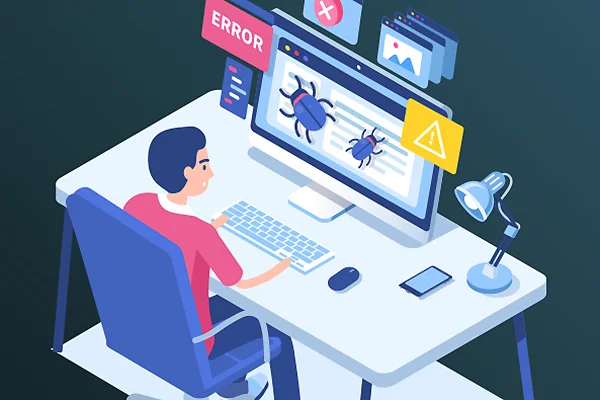Imagine your application as a grand theatre performance. Each actor, from the spotlight operator to the lead vocalist, must play their role perfectly. A single missed cue—a late spotlight or a wrong note—can disrupt the entire show. In the same way, a full-stack application is a performance where the front-end, back-end, and everything in between must work in harmony.
Debugging this layered production is not just about chasing errors; it’s about identifying which part of the orchestra is out of tune and ensuring the whole performance continues smoothly.
Peeling Back the Curtains: Front-End Debugging
The audience sees only what happens on stage—the colourful visuals, the transitions, the user interactions. But behind every polished act lies countless rehearsals filled with missteps. Debugging the front-end is similar. You’re dealing with errors that affect what the user directly experiences: buttons that refuse to respond, layouts that shift unpredictably, or scripts that break with mysterious red messages in the console.
To tame these issues, developers rely on browser tools like Chrome DevTools or Firefox Debugger. Inspecting elements, stepping through JavaScript line by line, and tracing CSS conflicts becomes the equivalent of a director fine-tuning a rehearsal. It’s about patience, observation, and adjusting one spotlight at a time until the audience sees perfection.
Backstage Mechanics: Back-End Troubleshooting
If the front-end is the performance, the back-end is the machinery backstage. It powers the lights, manages the microphones, and ensures the set changes without delay. When something goes wrong here, the show stalls completely. Server crashes, database misfires, or slow API responses are the unseen flaws that ripple out to the entire audience.
Debugging the back-end often requires log analysis, performance monitoring, and systematic testing. Logs are like handwritten notes left by the stage crew, explaining what broke and when. A good developer learns to read between these lines, tracing a failed database query or a missing environment variable back to its root cause. Just as stagehands ensure props are ready at the right time, back-end engineers must guarantee that every request is processed seamlessly.
The Orchestra Pit: Middleware and APIs
Between the dazzling performance and the backstage crew lies the orchestra pit—the middleware and APIs. Here, communication between sections of the show happens continuously. APIs transfer information like sheet music, ensuring the singers and instrumentalists remain in sync. But what if a musician misreads a note? Suddenly, harmony collapses.
Debugging this layer involves tools like Postman, curl, or API gateways. A malformed request or mismatched schema can trigger hours of head-scratching. Success comes from methodical testing: breaking down calls into smaller pieces, examining headers, payloads, and authentication tokens until the harmony is restored. This is where developers learn the importance of structured communication—without it, the performance loses rhythm.
When Sound Meets Light: Full-Stack Integration Issues
Even when front-end, back-end, and APIs work fine independently, issues often arise when they interact. It’s like the moment the lights and music must coordinate for a climactic scene. If the spotlight turns on a beat too late, the audience feels the disconnect. Integration bugs are tricky because they live in the seams, where systems meet and expectations don’t align.
End-to-end testing frameworks, containerised environments, and version control histories help pinpoint these problems. Running integration tests can highlight mismatches between expected and actual outcomes, much like rehearsals reveal timing flaws between singers and the orchestra. Developers who master this craft often train systematically, sometimes through structured learning such as enrolling in the Best Full Stack course, which provides not just technical knowledge but also habits for diagnosing cross-layer issues.
The Role of Documentation and Team Collaboration
Debugging is rarely a solo act. Just as a theatre production requires stage managers, costume designers, and lighting technicians, modern applications demand collaborative debugging. Clear documentation serves as the playbook that prevents repeated mistakes. Peer reviews and pair programming sessions add fresh eyes to stale problems, ensuring no detail is overlooked.
Collaboration also minimises downtime. Instead of one actor shouldering the entire responsibility, the team becomes an ensemble—sharing insights, correcting missteps, and refining the production. This cooperative spirit mirrors how developers today learn within communities, sharing debugging strategies and even pointing peers towards resources like the Best Full Stack course, where both technical depth and collaborative practices are emphasised.
Conclusion
Debugging across the full stack is less about hunting for isolated errors and more about directing a seamless performance. From the visible front-end to the invisible back-end, from APIs that act as musical bridges to integration tests that perfect timing, every layer must be understood in its context. Just like a theatre show relies on harmony among dozens of moving parts, your application thrives only when every actor plays their role without falter.
By embracing patience, observation, and collaboration, developers can transform debugging from a frustrating chore into an art form. The next time your application falters, imagine yourself not as a coder drowning in logs but as the director of a grand performance—one determined to bring every spotlight, sound, and script back into perfect synchrony.





